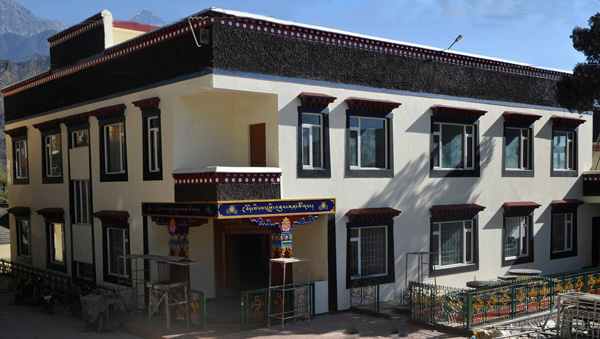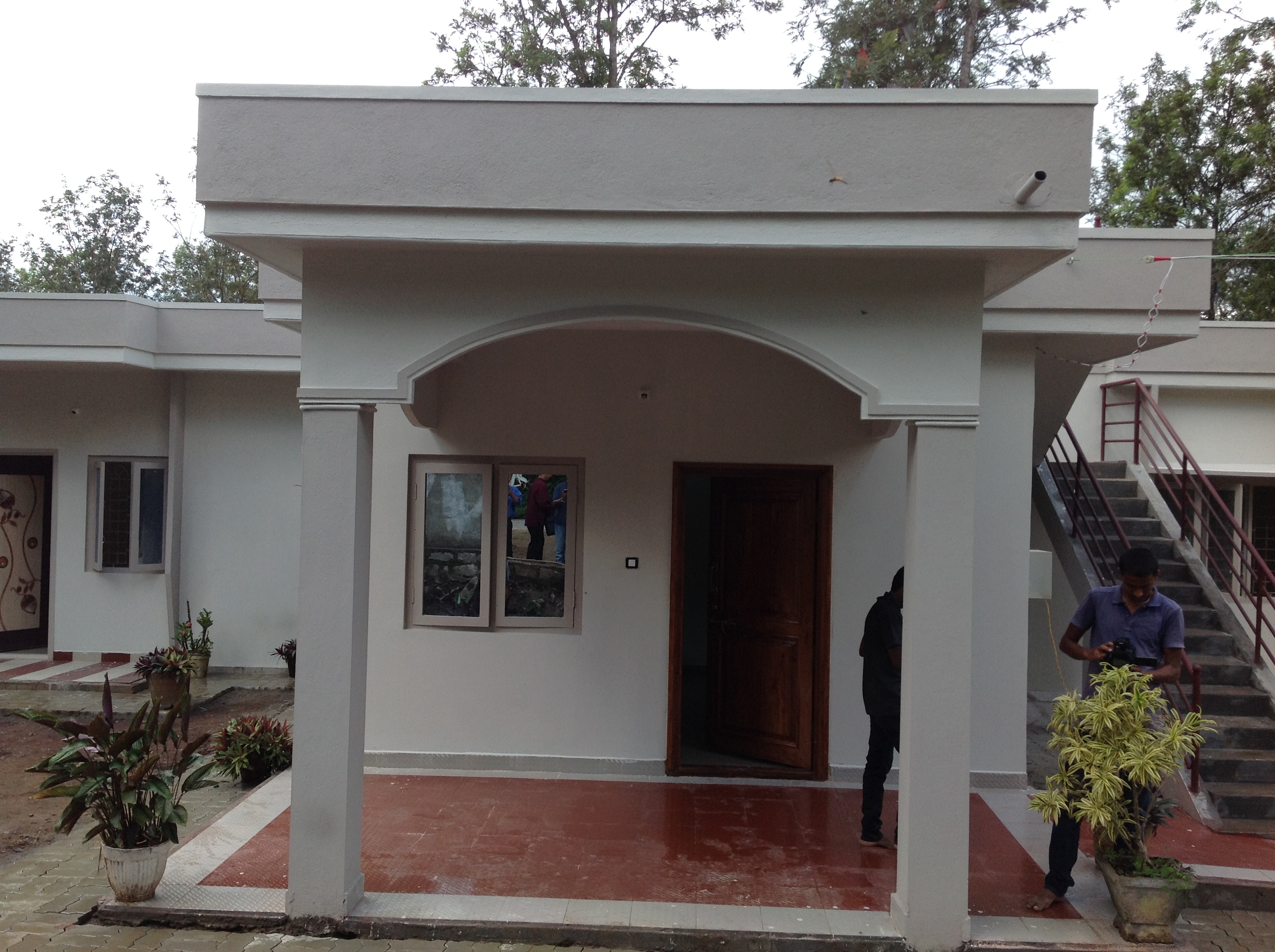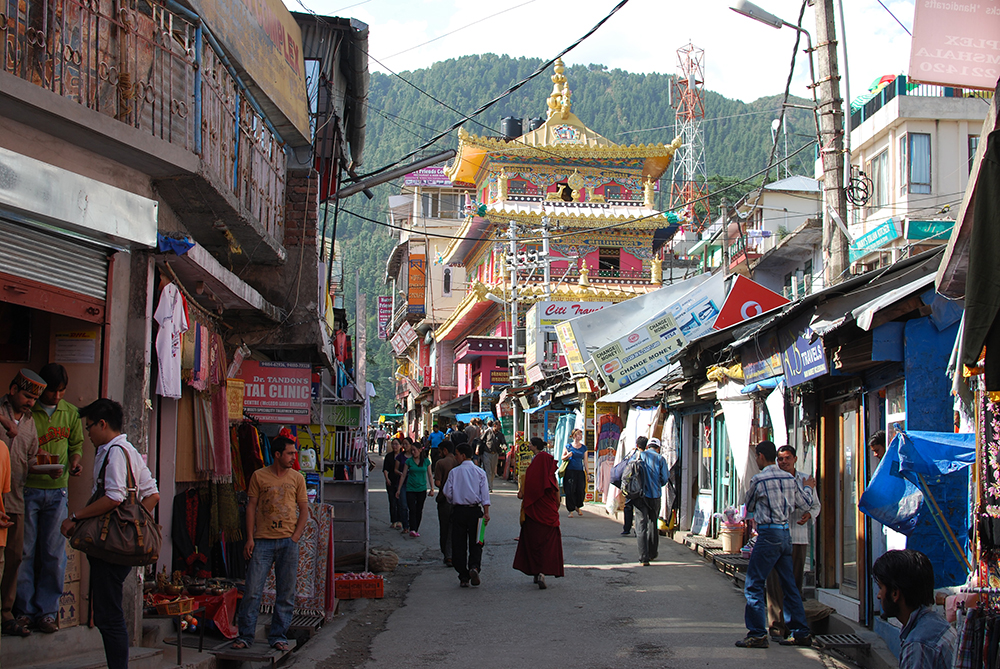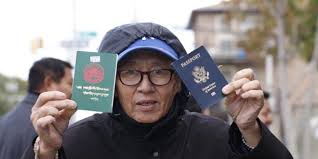One of the most difficult aspects of life as a refugee must surely be the uncertainty that accompanies such an existence. This uncertainty reflects a lack of control over one’s life – where do I live? How will I get money? What work can I do? Who will take me in? Where will I raise my kids? Hence in most refugee communities around the world, the predominant trait that drives the life of a refugee is the determination, willingness and desire to get out of such a state.
When the Tibetan community is analyzed, it is very difficult for any honest individual to classify the community as refugees. As a result of 60 years of publicity and awareness-raising, and thanks to the reputation of His Holiness the Dalai Lama, the Tibetan exile community is one of the most famous and most wealthy so-called refugee communities around the world.

The Tibetan Parliament in Exile in Dharamsala, North India. The men and women who occupy this building often have more than one passport, and own properties in other countries. The Tibetan Prime Minister Lobsang Sangay, for example, owns a home in the United States with a fully-paid mortgage. Is it any wonder the leadership want their people to stay as refugees in the eyes of the world, when it has been such a lucrative scheme?
A casual visit to any of the Tibetan settlements makes this plainly obvious. The homes are large, some with swimming pools, and in their well-manicured gardens sit large cars. Side by side to these large homes are huge golden temples filled with jewels and offerings, large statues and precious relics, and surrounding the settlements are bountiful farms to produce food for the world’s wealthiest refugees. This is in stark contrast to the hundreds of millions of Indians all around them, who struggle to get enough to eat every day.
Tibetans Today
But it is precisely this situation that the Central Tibetan Administration (CTA) are reluctant to leave behind, and precisely why after 60 years the CTA (the Tibetan leadership based in Dharamsala) continue to falsely refer to themselves as refugees. This life of luxury and wealth, which is not seen in any other refugee community in the world, has been funded for six decades by many countries who wanted to help them preserve their religion and unique way of life. But here are some points everyone needs to seriously consider:
- After so many years of financial and moral support, how can anyone still be a refugee? How can anyone be happy to call themselves a refugee after six decades of exploiting other people’s goodwill towards them? Perhaps 30 or 40 years ago, it would have been easy to believe the CTA kept their people as refugees and refused to allow them to become citizens of other countries because they wanted to keep alive the hope of returning to their homeland. But after so many years and so little progress on the Tibetan cause, how can the CTA continue to justify enforcing the refugee mentality on their people, instead of helping them put down roots and improve their lives?
- Today, there is definitely nothing about the Tibetan community that is actually refugee-like. Of the approximately 150,000 exiled Tibetans, a large group of them have naturalized into the USA, Europe and Australia as citizens. The remainder who live in India languish in a state of limbo – not wealthy enough to go to Western countries to seek refuge, they are also not Indian enough to access all the rights and privileges afforded to Indian citizens. What’s more, if they try to, their own Tibetan leadership sabotages their efforts to improve their lives.

A home for retired staff from the Tibetan leadership. Most Indians can only dream of living in such a home. What other supposedly besieged refugee community in the world provides such comfortable living quarters for their staff?
- History has shown that the CTA keeps the Tibetans as refugees because it serves their own interests. In their corruptness, they became spoiled from the funding they received for free from many generous, well-meaning nations who believed their refugee sales pitch. The evidence of this? The fact that as of 2012, the CTA has received over US$2bil in funding but the settlements, while wealthier than many other refugee communities, certainly do not reflect US$2bil worth of investment. There have been accusations from long-term Tibet supporters of financial mismanagement and wasteful aid and spending.
- It is clear that the CTA fields the refugee card because it denotes poverty, separation, disease, insecurity, torture, hunger, sickness and human rights abuses. The refugee card is an easy way to tell the public, without requiring much explanation, exactly why they should give their hard-earned money to the Tibetan leadership. Tibetans however, do not fit into any of these categories because they do not face any of these problems, unlike other refugees. Tibetans have schools, hospitals, shops, restaurants, businesses, and can send their children to Western countries to further their education. They have huge tracts of land, own hotels, operate tour agencies, hire and rent cars and buses. Do the refugees of Syria, for example, all have that?

Playing the refugee card has been a lucrative business for the Tibetan leadership. This is Dharamsala in North India, where the Tibetan leadership is based. This is not how most people would imagine refugees to be living.
- Their actions indicate that the CTA thinks fielding the refugee card works in their favor. Once they stop being identified as refugees, and once they become citizens of any country, their Free Money Tap is switched off and the flow of easy cash into their pockets will dry up. So it is not that the CTA actually cares about their people’s welfare or the preservation of the Tibetan culture. In actuality, it would be more accurate to say that the CTA is afraid of their people naturalizing into any nation because when the number of refugees shrink, it will reduce their opportunities to exploit their people’s situation, in order to line their own pockets with more money.
Everyone Is Not Created Equal
The CTA’s reluctance for their people to take on citizenship from other countries would be easier to bear if they were reluctant towards all citizenships, but this is not the case. Shockingly, the CTA continues to have double standards towards who can naturalize as a citizen and who may not. In essence:
- The Tibetan leadership appears to be practicing race-based politics. Tibetans who wish to naturalize as American, European or Australian citizens are encouraged; Tibetans who have no way of getting to those countries and instead seek to become Indian citizens, are lambasted and accused of being traitors to Tibet. In fact, the CTA intentionally creates obstacles and difficulties for Tibetans who wish to seek Indian citizenship, but they create no such obstacles for those hoping to get to the US, Europe or Australia.

This Tibetan man carries both his green Tibetan tax book (which allows him to vote in Tibetan elections) and his American passport. As time goes on, and as more exiled Tibetans leave the Tibetan settlements for other countries, the Tibetan leadership’s control over their people will wane as Tibetans get a taste of real freedom outside the purview of their leadership.
- What this highlights is the Tibetan leadership’s racist belief that it is good to be American, European and Australian, but it is bad to be Indian. And what is shocking about that is the fact that India, out of all the nations in the world, has been the kindest to the Tibetans, being the very first to take them in as refugees in 1959. Without India’s kindness, the Tibetan community would not have had safe haven when they fled into exile; without India’s kindness, the Tibetan community would not even exist today.
- How come Tibetan-Americans are considered Tibetan and they are not accused of abandoning the Tibetan cause, but Tibetan-Indians are insulted as traitors to Tibet? Why does the CTA consider Tibetan-Indians to be less “Tibetan” than Tibetan-Americans? The simple reason for this disparity is that the CTA considers Tibetan-Indians to be less desirable than Tibetan-Americans.
As the old adage goes, beggars cannot be choosers and if they were real refugees, would the CTA really care who their people gained citizenship from, as long as their people received refuge and a safe place to live and raise their kids?
And although the Tibetan leadership have been insulting India as a second-rate option for citizenship, the Indian government continues to be kind to the Tibetan community. After 60 years of generosity, the Indian government are still making it easier and easier for Tibetans to become Indians. Understanding that not all Tibetans can go to Western countries to improve their lives, but that Tibetans in India deserve opportunities too, India has been making it possible for more Tibetans to receive Indian citizenship, and therefore improving their access to greater employment and entrepreneurial opportunities.
What It All Boils Down To
It is therefore a good thing that Tibetans will be participating in the upcoming Himachal Pradesh elections, and getting more involved in Indian affairs. The fact is that India has been very kind to the Tibetans and it is time for Tibetans to contribute to India through their votes. Of course the Tibetan leadership will not be happy with this and would prefer to keep their people in an insular state of blissful ignorance, focused only on Tibetan affairs. To allow their people to become aware of the workings of the wider world, is to broaden their people’s opportunities beyond the control of the leadership.
At the end of the day, it is not whether someone is Tibetan-American or Tibetan-European or Tibetan-Indian. What it really boils down to is that the Tibetan leadership are motivated by money and power, and by keeping their people as refugees, they have access to an easy income stream from the donations people funnel to Tibetan refugees. When Tibetans start becoming Indians, when they start participating in local elections and when they identify with the laws and activities of their host nations, the CTA loses control because now, their people have options. And what these options really translate to is the option not to listen to the CTA because if the Tibetan leadership is too oppressive in the future, the Tibetans now have another citizenship to fall back on.
Hence losing their refugee status which they use to get money basically means the CTA falling flat on their faces; without their refugee status, they have no money and without their refugee status, they have no Tibetans to control. What we are witnessing is, in effect, the beginning of the end of the CTA as more and more Tibetans wake up to the abuse and exploitation they have suffered under their leadership for the last 60 years.
Tibetans excited about voting in
Himachal Pradesh polls but exiles voice worries

Click to read the full report
MORE NEWS LIKE THIS